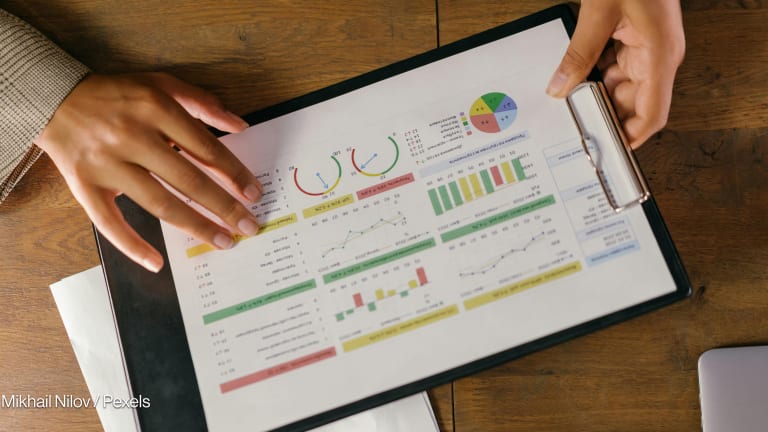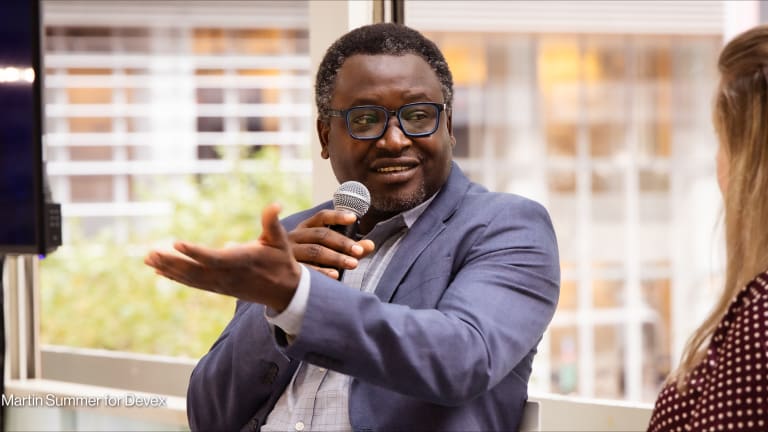If data is collected in communities, shouldn't it belong to communities?
For years, data has been collected about the global south by governments, INGOs, and U.N. agencies. Communities haven't had power over what was collected, nor have they seen results of the research. Now, it's time for a change.
The closure of USAID has had many implications. One of the less-reported ones: The loss of many critical datasets, such as the Demographic and Health Surveys, or DHS, which USAID has backed for years. It’s prompted a question. Does it really make sense for countries and communities to rely on data collected by large institutions in the global north, and stored in northern research institutes and universities? Haoyi Chen, lead of Citizen Data and Data Integration at the United Nations Statistics Division, says that it is time for countries to build resilient systems of their own. But along with the top-down methods we’ve seen before, she and others believe there’s another powerful tool, which should be a larger part of the mix: citizen-generated data — data collected by, or in partnership with, communities themselves. Local data gaps, local voices What citizen-generated data lacks in scale, it makes up for in granularity. It can help to fill information gaps that administrative data or data collected by large NGOs often miss. Administrative data is often high-level — a list of educational or health facilities, for example — but it doesn’t always capture local knowledge. “Community members know where things are, and they know whether things are broken, and they know whether a line on a map is a passable road or not,” said Jenna Slotin, managing director at Global Partnership for Sustainable Development Data. Citizen-generated data can also provide insight into the subjective, lived experiences of communities. Chen worked in collaboration with one initiative in Kenya, for example, where school absenteeism was high, despite a primary school nearby. A citizen data project helped reveal that children were scared to walk to school because the area was inhabited by elephants. A solution was devised to ensure their safety, and school attendance increased. With administrative data, often “we don’t get to the why,” explained Chen. Because citizen-generated data is more granular, Chen said, interventions can often have an immediate impact and are better targeted toward vulnerable populations, which donors love. Citizen data can also do a better job of capturing the needs of marginalized groups, such as disabled people or informal workers. Slotin said that top-level statistics used to set national policy can suffer from “the tyranny of averages,” which only sees the typical individuals in the middle, and not the people at the ends of the bell curve, who can have different needs. “As a consequence, those people and their experience are just completely invisible,” she said. So, how to strengthen the voice of local citizens in data-driven policymaking? That’s the job of organizations such as Twaweza, a nonprofit in East Africa. “We are trying to get more and more people to respect the local experiences, the citizens’ perspectives and expectations and views and fears and priorities,” said Aidan Eyakuze, its former executive director. Citizen-led data may have limitations. The data quality is not consistent, and datasets are unlikely to be easily comparable with each other. Information may not flow easily from communities to civil society organizations to national and international agencies. However, at root, citizen data is not intended to replace large multinational datasets, but to complement them. There are things that citizen data can do that administrative data cannot. Meanwhile, the Collaborative on Citizen Data is working to strengthen the quality of citizen data. Co-led by the U.N. Statistics Division, it devised the Copenhagen Framework on Citizen Data last year. The Framework helps guide citizens and civil society organizations on how to improve their data quality by asking the right questions. Are samples representative? Is the methodology clear? Can the results be replicated? Who owns the data? When data on local communities is collected by governments, multilaterals, and INGOS, people in those communities often never get to see it — let alone help use it to make decisions. Historically, said Slotin, “data has been collected from people ... without them having any understanding of how that data is going to be used.” The first step is “to reconnect that feedback loop,” she said. For Twaweza, this means that “we go back and tell them, this is what we found,” said Eyakuze. That means when data is collected on the reading levels of schoolchildren, it doesn’t just go to policymakers. It’s sent back to parents and teachers and used to help those kids to read better. But it’s not just about sharing the data collected by others. It’s about training community members to collect the data themselves. Healing Fields, an NGO facilitating community-driven health innovations in rural India, trains local women known as Community Health Entrepreneurs, or CHEs, to do just that. CHEs learn to use data to identify local health concerns and then choose their own projects to work on, based on what their communities need most. Kaushalya Devi, a CHE living in Bihar, decided to focus on the issue of open defecation after discovering during a door-to-door survey that many of her neighbours did not have toilets. “Before we had no idea how many had toilets or not, and how many were actually using them,” she said. Using the data to strengthen her case, she successfully advocated with local leaders for the construction of 25-30 more toilets in the village. “We are training leaders in the community, change agents,” said Mukti Bosco, Healing Fields co-founder and CEO. “Therefore, it is for them to decide what is most valuable for them, for the community.” Devi has since led other data initiatives, such as a survey on insurance coverage, which helped five families to claim missing government entitlements. Many of the women now come to her with their problems, she said. “I live in the village, so they see me on a regular basis and they trust me and ask me for advice,” she said. It’s important that community members play an active role not just in data collection, but also in survey design. Right now, large NGOs or research institutes may see community surveyors as just “a cheaper way to collect data,” said Joe Massey, senior researcher at the Open Data Institute. Citizen preferences and needs may easily be “silenced and overwhelmed” by the needs of big institutions, said Eyakuze. But communities that participate in the design process may feel more agency, and understanding their own data can empower them to advocate for change. Those communities’ problems become “harder to ignore,” said Slotin. By the end of their training, CHEs at Healing Fields understand how data “can be used for influencing and how it can be used to get stuff done,” said Bosco, providing them with the confidence and data literacy skills to run data collection projects in the future without the help of the NGO. Funding needed While awareness of the potential benefits of citizen-generated data is growing, experts agreed that funding remains a problem. External donors have shown lots of interest in the community-level data being generated by Healing Fields, said Bosco, especially as few datasets in India contain that level of specificity. Data collected by CHEs covers 700,000 people in rural villages across three states of India, enabling donors to zoom in on local problems and serve some of India’s most vulnerable populations, she said. But finding donors willing to help the NGO invest in better data systems has been difficult, she said. “People want to talk about how important hyper-local data is. But who is willing to fund the foundation of the data collection?” she asked. Potentially higher costs and longer time frames can dissuade donors, said Massey. “It takes time to build trust, it takes time to work with a community, and that needs to be factored in,” he said. For large NGOs or governments that may be constrained by strict timelines or accountability to taxpayers, “there’s a trade-off, there’s a tension sometimes, if the timelines don’t align,” said Slotin. Recent cuts to foreign aid have exacerbated the shortfall, with the funding situation currently “dire across the board,” said Slotin, with citizen-generated data “no exception.” If governments are serious about building more resilient systems, they will need to invest in citizen-generated data themselves, said Chen. There is already a huge level of interest in countries such as Colombia and India, she said. Citizen data initiatives rarely receive financial support from the government, but “we’re really advocating for governments also allocating funding to civil society organizations,” she said.
The closure of USAID has had many implications. One of the less-reported ones: The loss of many critical datasets, such as the Demographic and Health Surveys, or DHS, which USAID has backed for years.
It’s prompted a question. Does it really make sense for countries and communities to rely on data collected by large institutions in the global north, and stored in northern research institutes and universities?
Haoyi Chen, lead of Citizen Data and Data Integration at the United Nations Statistics Division, says that it is time for countries to build resilient systems of their own.
This article is free to read - just register or sign in
Access news, newsletters, events and more.
Join usSign inPrinting articles to share with others is a breach of our terms and conditions and copyright policy. Please use the sharing options on the left side of the article. Devex Pro members may share up to 10 articles per month using the Pro share tool ( ).
Catherine Davison is an independent journalist based in Delhi, India, writing on issues at the intersection of health, gender, and the environment.








